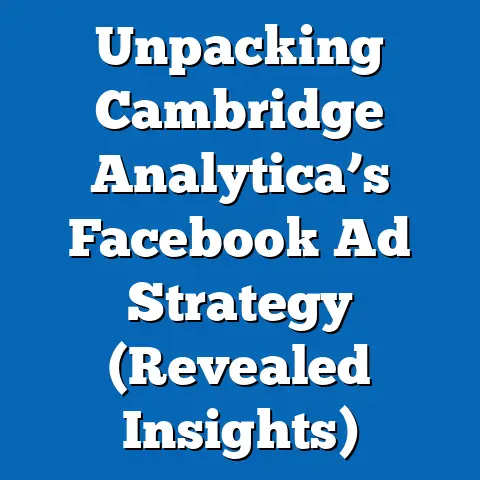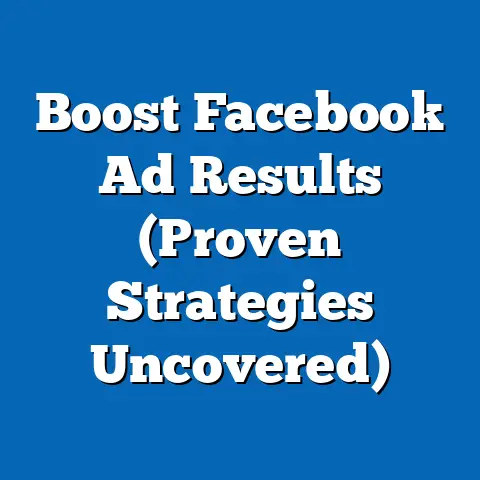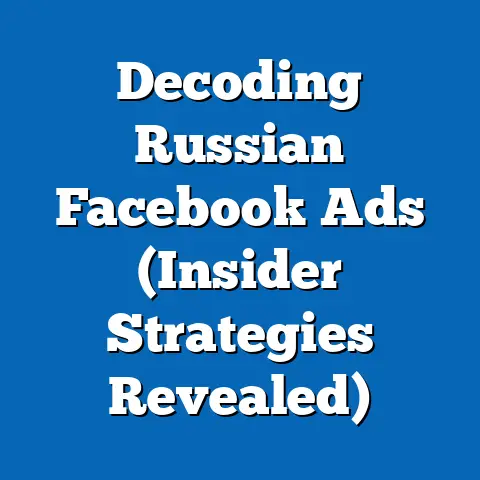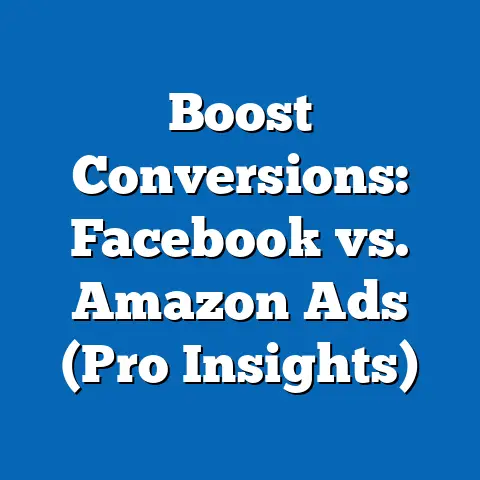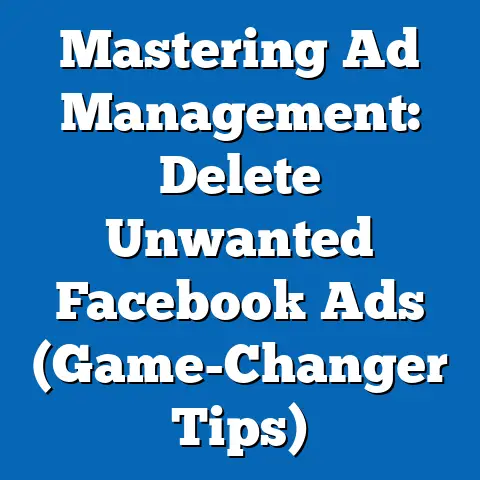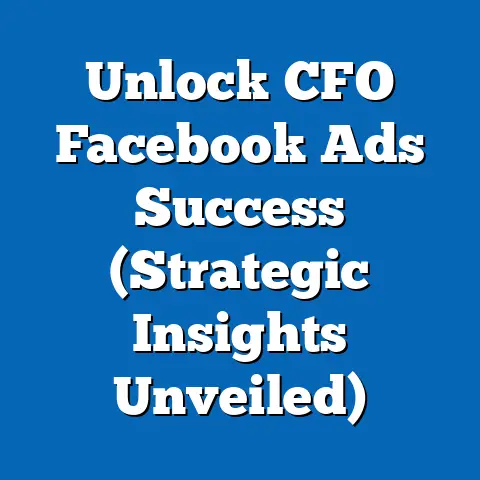Revamp Landing Page for Facebook Ads (Maximize Conversions)
In the ever-evolving world of digital marketing, stagnation is the enemy. I’ve seen firsthand how quickly strategies that once brought in a flood of leads can suddenly dry up. The reason? Consumer behavior is constantly shifting, influenced by new technologies, trends, and even the ads they see from your competitors. That’s why I believe innovation isn’t just a buzzword; it’s a necessity. And one of the most critical areas for continuous improvement, especially when running Facebook ads, is your landing page. It’s the digital storefront where potential customers decide whether to buy what you’re selling, both literally and figuratively. It’s the final stage of your sales funnel, where all your hard work in crafting the perfect ad comes to fruition – or falls flat.
The Importance of Landing Pages in Facebook Ads
Let’s start with the basics. What exactly is a landing page, and why is it so vital in the context of Facebook advertising?
Defining the Landing Page
A landing page is a standalone web page created specifically for a marketing or advertising campaign. It’s where a visitor “lands” after clicking on a link in an email, ad, or other digital location. Unlike a regular website page, which is designed to explore various aspects of a business, a landing page has a single, focused objective: to convert visitors into leads or customers. This conversion could be anything from signing up for a newsletter to requesting a demo, or even making a direct purchase.
Landing Pages vs. Regular Web Pages: A Critical Distinction
The key difference lies in the intent. Regular web pages are designed for exploration and information gathering. Think of your homepage, your “About Us” page, or your blog. These pages serve a broad purpose and cater to visitors at various stages of the customer journey.
Landing pages, on the other hand, are laser-focused. They’re designed to eliminate distractions and guide the visitor towards a specific action. Imagine someone clicking on your Facebook ad promising a free e-book. They expect to land on a page that directly offers that e-book in exchange for their email address, not a page cluttered with unrelated products or services.
I’ve seen countless campaigns fail simply because the ad led to a generic website page. The visitor gets confused, overwhelmed, and ultimately leaves without converting.
The Facebook Ad – Landing Page Synergy: Guiding the User Journey
The magic happens when your Facebook ad and landing page work together seamlessly. The ad creates awareness and generates interest, while the landing page seals the deal. This synergy is crucial for a successful campaign.
The user journey should be smooth and intuitive. The messaging in your ad should align perfectly with the messaging on your landing page. The visuals should be consistent, and the offer should be clear and compelling.
I remember working with a client in the fitness industry who was running Facebook ads to promote a free 7-day gym pass. Their initial landing page was simply a form asking for basic contact information. The conversion rate was abysmal. After revamping the landing page to include a video tour of the gym, testimonials from satisfied members, and a more compelling headline highlighting the benefits of the pass, their conversion rate skyrocketed by over 300%.
Takeaway: A well-designed landing page is the bridge between your Facebook ad and a conversion. It’s the final step in the user journey, and it needs to be optimized for a specific goal.
Understanding the Factors That Influence Conversion Rates
Before diving into specific techniques, it’s essential to understand the underlying factors that drive conversion rates on landing pages.
The Power of Numbers: Landing Page Optimization Statistics
Let’s face it, data talks. Here are some key statistics that highlight the importance of landing page optimization:
- Average Landing Page Conversion Rate: Across all industries, the average landing page conversion rate hovers around 2.35% (WordStream). That means only a small percentage of visitors are actually taking the desired action. This underscores the massive potential for improvement.
- Top 10% Conversion Rate: The top 10% of companies achieve conversion rates of 11.45% or higher (WordStream). This shows what’s possible with a well-optimized landing page.
- Mobile Optimization Impact: Mobile-optimized landing pages can increase conversion rates by up to 25% (HubSpot). Given that a significant portion of Facebook users access the platform on their mobile devices, this is crucial.
- Load Time Matters: A one-second delay in page load time can decrease conversions by 7% (Neil Patel). Speed is critical for keeping visitors engaged.
These numbers clearly demonstrate the impact of landing page optimization. Small changes can lead to significant improvements in conversion rates.
Psychological Triggers: Tapping into Human Behavior
Conversion isn’t just about design and technical aspects; it’s also about understanding human psychology. Certain psychological triggers can significantly influence a visitor’s decision to convert.
- Trust: People are more likely to convert if they trust your brand. Displaying security badges, testimonials, and guarantees can build trust.
- Urgency: Creating a sense of urgency can motivate visitors to act quickly. Limited-time offers, countdown timers, and scarcity tactics can be effective.
- Relevance: Your landing page should be highly relevant to the ad that brought the visitor there. Mismatched messaging can lead to confusion and abandonment.
- Authority: Showcasing your expertise and authority in your industry can increase credibility and influence.
- Social Proof: People are influenced by the actions of others. Displaying reviews, ratings, and testimonials can encourage conversions.
I remember one campaign where we simply added a customer testimonial to the landing page, and the conversion rate jumped by 15%. It was a simple change, but it had a significant impact because it tapped into the power of social proof.
User Experience (UX): The Foundation of Conversion
User experience plays a critical role in conversion rates. A poorly designed landing page can frustrate visitors and drive them away, regardless of how compelling your offer is.
- Load Times: As mentioned earlier, speed is crucial. Optimize your images, minimize your code, and use a reliable hosting provider to ensure fast load times.
- Mobile Responsiveness: Ensure your landing page is fully responsive and looks great on all devices. Mobile users should have a seamless experience.
- Overall Design: Keep your design clean, simple, and uncluttered. Use clear headings, concise copy, and high-quality visuals to guide the visitor’s eye.
- Navigation: Make it easy for visitors to navigate your landing page and find the information they need.
- Accessibility: Ensure your landing page is accessible to users with disabilities.
I once audited a landing page that took over 10 seconds to load on mobile. No surprise, the conversion rate was terrible. After optimizing the images and code, we reduced the load time to under 3 seconds, and the conversion rate tripled.
Takeaway: Understanding the factors that influence conversion rates – from statistics to psychology to user experience – is crucial for effective landing page optimization.
Key Elements of an Effective Landing Page
Now, let’s break down the key elements that make up a high-converting landing page.
Headlines: Capturing Attention in Seconds
Your headline is the first thing visitors see, and it needs to grab their attention immediately. It should be clear, concise, and compelling, highlighting the main benefit of your offer.
- Use Strong Verbs: Action verbs like “discover,” “learn,” and “get” can create a sense of excitement and urgency.
- Highlight the Benefit: Focus on what the visitor will gain by converting. For example, “Download Your Free E-book and Learn How to Double Your Sales.”
- Keep it Short and Sweet: Aim for a headline that’s easy to read and understand in a few seconds.
- Use Numbers: Numbers can add credibility and make your headline more attention-grabbing. For example, “5 Proven Strategies to Increase Your Website Traffic.”
I often use headline analyzer tools to test different variations and see which ones perform best. It’s a simple way to optimize your headline for maximum impact.
Visuals: Enhancing Engagement and Understanding
High-quality images and videos can significantly enhance user engagement and help communicate your message more effectively.
- Use Relevant Images: Choose images that are relevant to your offer and target audience. Avoid generic stock photos that look unnatural.
- Showcase Your Product: If you’re selling a product, showcase it in action with high-quality photos or videos.
- Use Video Testimonials: Video testimonials can be incredibly powerful for building trust and credibility.
- Optimize for Speed: Compress your images and videos to ensure fast load times.
I’ve found that using images of real people, especially customers, can be more effective than using abstract graphics. It helps create a connection with the visitor and makes your offer more relatable.
Copy: Persuading with Words
Your landing page copy should be persuasive and resonate with your target audience. It should clearly explain the benefits of your offer and address any potential concerns.
- Focus on Benefits, Not Features: Explain how your offer will solve the visitor’s problem or improve their life.
- Use Concise Language: Avoid jargon and technical terms. Keep your copy simple and easy to understand.
- Highlight Key Selling Points: Emphasize the unique advantages of your offer.
- Use Social Proof: Include testimonials, reviews, and case studies to build trust and credibility.
I often use the “AIDA” framework (Attention, Interest, Desire, Action) to structure my landing page copy. It’s a simple yet effective way to guide the visitor through the conversion process.
Call-to-Action (CTA): Guiding the Visitor to Convert
Your CTA is the most important element on your landing page. It should be clear, concise, and visually prominent, telling the visitor exactly what you want them to do.
- Use Action Verbs: Use strong action verbs like “download,” “sign up,” “get started,” and “learn more.”
- Make it Visually Appealing: Use a contrasting color and a clear font to make your CTA stand out.
- Place it Strategically: Place your CTA above the fold and in multiple locations on your landing page.
- Create a Sense of Urgency: Use phrases like “limited time offer” or “get it now” to encourage immediate action.
I always A/B test different CTA variations to see which ones perform best. Even small changes in wording or design can have a significant impact on conversion rates.
Forms: Minimizing Friction for Maximum Conversions
If your landing page requires visitors to fill out a form, it’s essential to minimize friction and make the process as easy as possible.
- Minimize the Number of Fields: Only ask for the information you absolutely need.
- Use Clear Labels: Make sure each field is clearly labeled and easy to understand.
- Optimize for Mobile: Ensure your form is mobile-friendly and easy to fill out on a small screen.
- Use Auto-Fill: Enable auto-fill to make it easier for visitors to complete the form.
- Provide Clear Error Messages: If a visitor makes a mistake, provide clear and helpful error messages.
I’ve found that using progressive profiling, where you gradually collect more information from visitors over time, can be an effective way to minimize form friction.
Takeaway: Each element of your landing page plays a crucial role in driving conversions. Optimizing each element individually can lead to significant improvements in overall performance.
Techniques to Revamp Your Landing Page
Now that you understand the key elements of an effective landing page, let’s dive into some specific techniques for revamping your existing pages.
A/B Testing: The Key to Continuous Improvement
A/B testing, also known as split testing, is the process of comparing two versions of a landing page to see which one performs better. It’s a data-driven approach to optimization that allows you to make informed decisions based on real user behavior.
- Test One Element at a Time: To get accurate results, only test one element at a time. For example, test different headlines, CTAs, or images.
- Use a Reliable Testing Tool: There are many A/B testing tools available, such as Google Optimize, Optimizely, and VWO.
- Run Your Tests Long Enough: Make sure to run your tests long enough to gather statistically significant data.
- Analyze Your Results: Carefully analyze your results to identify which version performed better and why.
I always start with a hypothesis before running an A/B test. For example, “I believe that changing the CTA color from blue to green will increase conversions.” This helps me focus my testing and analyze my results more effectively.
User Feedback: Listening to Your Audience
Collecting and analyzing user feedback can provide valuable insights into how to improve your landing page.
- Use Surveys: Use surveys to gather feedback on specific aspects of your landing page.
- Conduct User Interviews: Conduct user interviews to get more in-depth feedback.
- Monitor Social Media: Monitor social media for mentions of your brand and landing page.
- Read Customer Reviews: Read customer reviews to see what people are saying about your products or services.
I often use heatmaps and scroll maps to see how visitors are interacting with my landing page. This can help me identify areas where visitors are getting stuck or losing interest.
Analytics Review: Tracking User Behavior and Conversion Metrics
Utilizing tools like Google Analytics can provide valuable data on user behavior and conversion metrics.
- Track Key Metrics: Track key metrics like bounce rate, time on page, conversion rate, and cost per acquisition.
- Identify Problem Areas: Use analytics to identify areas where visitors are dropping off or experiencing difficulties.
- Segment Your Data: Segment your data to see how different types of visitors are behaving on your landing page.
- Set Up Goals: Set up goals in Google Analytics to track specific conversions.
I always set up custom dashboards in Google Analytics to monitor the key metrics that are most important to me. This allows me to quickly identify any potential problems and take corrective action.
Competitor Analysis: Learning from the Best (and the Worst)
Examining your competitors’ landing pages can provide valuable inspiration and insights.
- Identify Top Competitors: Identify your top competitors and analyze their landing pages.
- See What’s Working: See what elements they’re using that seem to be working well.
- Identify Weaknesses: Identify any weaknesses in their landing pages that you can exploit.
- Don’t Copy, Adapt: Don’t simply copy your competitors’ landing pages. Adapt their ideas to fit your brand and target audience.
I often use tools like SEMrush and Ahrefs to analyze my competitors’ landing pages and see which keywords they’re targeting.
Takeaway: Revamping your landing page is an ongoing process that requires continuous testing, feedback, and analysis.
Advanced Strategies for Conversion Optimization
Once you’ve mastered the basics, you can start exploring some advanced strategies for conversion optimization.
Personalization: Tailoring Content to Individual Users
Personalization involves tailoring your landing page content to different audience segments based on their demographics, interests, and behavior.
- Use Dynamic Content: Use dynamic content to display different headlines, images, and copy to different users.
- Segment Your Audience: Segment your audience based on their demographics, interests, and behavior.
- Use Location-Based Personalization: Display different content based on the visitor’s location.
- Use Behavioral Personalization: Display different content based on the visitor’s past behavior on your website.
I’ve found that personalization can significantly increase conversion rates, especially when targeting specific audience segments.
Retargeting: Bringing Users Back to Your Landing Page
Retargeting involves showing ads to people who have previously visited your landing page but didn’t convert.
- Use Facebook Retargeting: Use Facebook retargeting to show ads to people who have visited your landing page.
- Create Custom Audiences: Create custom audiences based on specific actions visitors have taken on your landing page.
- Use Compelling Ad Copy: Use compelling ad copy that reminds visitors of the value of your offer.
- Offer a Discount or Incentive: Offer a discount or incentive to encourage visitors to convert.
I’ve found that retargeting can be a highly effective way to recover lost conversions.
Social Proof: Leveraging the Power of Influence
Social proof involves using testimonials, reviews, and case studies to build trust and credibility.
- Display Testimonials: Display testimonials from satisfied customers on your landing page.
- Showcase Reviews: Showcase positive reviews from third-party websites.
- Create Case Studies: Create case studies that demonstrate the value of your products or services.
- Use Social Media Mentions: Display social media mentions of your brand on your landing page.
I always try to include video testimonials on my landing pages whenever possible. They’re much more engaging and persuasive than written testimonials.
Scarcity and Urgency: Creating a Sense of Immediacy
Scarcity and urgency involve creating a sense of immediacy to encourage visitors to convert quickly.
- Use Limited-Time Offers: Offer limited-time discounts or promotions.
- Use Countdown Timers: Use countdown timers to create a sense of urgency.
- Highlight Low Stock Levels: Highlight low stock levels to create a sense of scarcity.
- Use Phrases Like “Get It Now”: Use phrases like “get it now” or “don’t miss out” to encourage immediate action.
I’ve found that using scarcity and urgency tactics can be highly effective, but it’s important to use them ethically and avoid misleading visitors.
Takeaway: Advanced strategies like personalization, retargeting, social proof, and scarcity can significantly boost your conversion rates.
Case Studies and Real-Life Examples
Let’s look at some real-life examples of businesses that successfully revamped their landing pages for Facebook ads and saw significant increases in conversions.
- Example 1: A SaaS Company: A SaaS company was running Facebook ads to promote a free trial of their software. Their initial landing page was simply a form asking for basic contact information. After revamping the landing page to include a video demo of the software, testimonials from satisfied customers, and a more compelling headline highlighting the benefits of the trial, their conversion rate increased by 40%.
- Example 2: An E-Commerce Store: An e-commerce store was running Facebook ads to promote a new product. Their initial landing page was simply a product page with a buy button. After revamping the landing page to include high-quality product photos, detailed product descriptions, customer reviews, and a limited-time discount, their conversion rate increased by 60%.
- Example 3: A Consulting Firm: A consulting firm was running Facebook ads to promote a free consultation. Their initial landing page was simply a form asking for basic contact information. After revamping the landing page to include a video introduction from the firm’s founder, testimonials from satisfied clients, and a more compelling headline highlighting the benefits of the consultation, their conversion rate increased by 50%.
These examples demonstrate the power of landing page optimization. Small changes can lead to significant improvements in conversion rates and ultimately drive more revenue for your business.
Conclusion
Landing pages are the unsung heroes of successful Facebook advertising campaigns. They’re the crucial link between your ad and a conversion, and they play a vital role in maximizing your ROI.
By understanding the key elements of an effective landing page, implementing proven optimization techniques, and continuously testing and refining your approach, you can create landing pages that convert visitors into leads and customers.
Remember, landing page optimization is an ongoing process. The digital landscape is constantly evolving, and your landing pages need to adapt to stay ahead of the curve. Embrace innovation, stay curious, and never stop testing. Your conversion rates will thank you for it.

